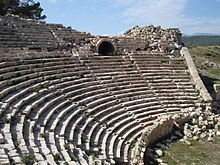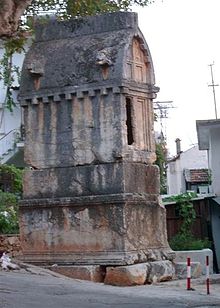Lycia
Lycia is the ancient Greek name for a landscape in the south-west of Asia Minor (Latin: Lycia ).
geography
The area that was called Lycia extends on the western of the two semicircular bulges of the south coast of Asia Minor. It took a while for firm boundaries to form; The area was probably less uniform for a long time than it appeared from the outside (originally, perhaps only the Xanthostal region was considered Lycia). Lycia borders with Caria in the west . The border ran roughly along the Axon River ( Kirten Dere ). It bordered Pisidia and Phrygia to the north and Pamphylia to the east . The landscape is sometimes very rough and rugged with peaks up to over 3000 meters. Lycia is roughly divided into four parts, a western, a central, an eastern and a northern part. Only the first three mentioned can be described as the Lycian core area, while northern Lycia, the so-called Milyas , formed a largely independent cultural landscape, which only began in the 4th century BC. Came to Lycia through the conquests of the dynast Perikles of Limyra . East and West Lycia also shaped between the 6th and 4th centuries BC. BC coins according to different standards.
The most important centers are Xanthos, already mentioned in the Iliad, with the famous Letoon , Patara , the central city of the Lycian League and seat of the provincial government in Roman times and famous for its oracle of Apollon , which was in competition with Delphi in the early days , Limyra and finally Myra with its famous rock tombs .
A special feature of Lycia are the so-called local pairs, a settlement pattern that is often encountered there. A port on the Mediterranean coast is assigned a corresponding location in the mountains. An example is Antiphellos , today's Kaş . In ancient times, the port city formed a community with the mountain village of Phellos in the nearby hinterland. Xanthos and the port city of Patara formed the most important pair of cities in Lycia. The ancient historian Martin Zimmermann dedicated his dissertation to this special type of settlement . With the couple Tyberissos and Timiussa ( Üçağız ) he found that foreign influences were primarily noticeable in the mountain settlement of Tyberissos, which was located on a hilltop that was difficult to access, but not in the port. In the case of Phellos-Antiphellos, however, it was the other way round: Here the Greek and later Roman influences spread in the port city, while the mountain settlement preserved Lycian traditions.
Ancient sites in Lycia
Acalissus , Andriake , Antiphellos , Aperlai , Apollonia , Araxa , Ariassos , Arif , Arneae , Arsada , Arykanda , Balbura , Bubon , Choma , Dikitanaura , Gagai , Gedelma , Idebessos , Idyros , Isinda , Istlada , Kadyanda , Kalynda , Kandyba , Karkabo , Kaunos , Komba, Korydalla , Krya , Kyaneai , Lebissos , Letoon , Limyra , Lissa, Lydai , Mastaura , Megiste , Melanippe , Myra , Nisa , Oinoanda , Olympos , Panormos , Patara , Phaselis , Phellos , Phoinix , Pinara , Podalia , Pydnai , Rhodiapolis , Sidyma , Simena , Sura , Symbra , Telmessos , Timiussa , Tlos , Tragalassos , Trebendai , Trysa , Tyberissos , Xanthos
Approx. 3 km east of the ruins of Limyra is the bridge at Limyra from Roman times . Four kilometers upstream from Kemer are the remains of the Roman bridge near Kemer on the right bank of the Xanthos River ( Eşen / Koca Çayı ) .
People and culture
The Lycians were a people with their own culture, their own script and their own language, Lycian . This Indo-European language belongs to the Luwian branch of the Anatolian languages . She died in the 3rd century BC Chr. From.
What is remarkable is the pronounced tendency to create representative tombs, which are almost omnipresent. The most conspicuous grave types include rock graves with facades using indigenous wood architecture, pillar graves (also known as grave pillars) such as the so-called harpy monument of Xanthos and stone sarcophagi with the ogival lids typical of the landscape. Already since the 6th century BC BC Lycia - although never really a Greek colonization area - was subject to Greek influence, which has been particularly evident since the 4th century BC. Chr. Reinforced.
history
In the Iliad , Lycians appear as allies of the Trojans under the leadership of their heroes Sarpedon and Glaucus . It is historically certain that Lycia, which Kroisos was unable to conquer, around 540 BC. Was captured by Persian troops. In the next two centuries or so, the country was ruled by a number of smaller princes, who were arguably fiercely competitive with each other and who were often referred to as dynasts in research . Until about 400 BC The dynasts of Xanthos seem to have dominated the country, but around 380 the dynast Pericles of Limyra seems to have succeeded in bringing all of Lycia under his control. He claimed the Greek title of basileus . But around 360 he was overthrown by the Persians with whom he had come into conflict. Lycia was subordinate to Mausolus II , the satrap of Caria; the time of the dynasties was over. In 334 Alexander the Great conquered the area, the rich cities and seaports offered him no resistance. Telmessos , Xanthos and Patara opened their gates to him, a Lycian alliance with 23 cities, a reorganized constitution and assembly. During the subsequent era of Hellenism , the Greek language and culture finally asserted themselves in the region. In 309 Lycia fell to the Ptolemies , 197 to the Seleucids , 188 to Rhodes . In 167 the Romans declared the area independent; at least now the country organized itself as the Lycian League . In 43 AD it was integrated as a province into the Roman Empire under Emperor Claudius , and since Vespasian , Lycia and its neighboring region formed the province of Lycia et Pamphylia for a good 200 years .
At 330, Nikolaus von Myra , a man from Patara , was Bishop of Myra, whose name day is celebrated on December 6th. Because of the pronounced, steep coastal landscape , he became patron of the seafarers, among other things . His bones were brought from Myra to Bari in the Middle Ages , where they can still be found today. The most famous Lycian next to Nicholas was probably the philosopher Proclus . The area was still flourishing under Justinian I ; It was not until the 7th century that the raids of the Arabs led to the decline and abandonment of many cities.
literature
- Johann Jakob Bachofen: The mother right (Lycia) Frankfurt am Main 1975, ISBN 3-518-27735-9 .
- Jürgen Borchhardt; Renate and Wolfgang Schiele (photos): The stones of Zemũri: Archaeological research on the hidden waters of Limyra. Phoibos, Vienna 1993, ISBN 3-901232-01-X .
- Hartwin Brandt , Frank Kolb: Lycia et Pamphylia. A Roman province in southwest Asia Minor. von Zabern, Mainz 2005, ISBN 3-8053-3470-2 .
- Trevor Bryce : The Lycians. Armindale 1986.
- Barbara H. Flemming: Landscape history of Pamphylia, Pisidia and Lycia in the late Middle Ages. Harrassowitz, Wiesbaden 1964, ISBN 3-447-04941-3 (= treatises for the customer of the Orient 35.1.).
- Peter Grossmann, Hans-Georg Severin: Early Christian and Byzantine buildings in southeastern Lycia. (= Istanbul Research , Volume 46.) Tübingen 2003, ISBN 3-8030-1767-X .
- Hansgerd Hellenkemper , Friedrich Hild : Lykien and Pamphylien. (= Tabula Imperii Byzantini , Volume 8.), Verlag der Österreichischen Akademie der Wissenschaft, Vienna 2004, ISBN 3-7001-3280-8 .
- Frank Kolb , Barbara Kupke: Lycia. Ancient history of Lycia. von Zabern, Mainz 1992, ISBN 3-8053-1415-9 ( Antike Welt , special issue; Zabern's illustrated books on archeology, Volume 2).
- Frank Kolb: Lycia. History of an ancient landscape . Scientific Book Society, Darmstadt 2018, ISBN 978-3-8053-5178-2 .
- Thomas Marksteiner: Lycia. An archaeological guide Phoibos, Vienna 2010. ISBN 978-3-85161-029-1
- Hans Rott: Monuments from Asia Minor from Pisidia, Pamphylia, Cappadocia and Lycia. (= Studies on Christian Monuments NF 5/6.) Leipzig 1908.
- Martin Zimmermann : Studies on the historical regional studies of Central Lycia. ( Antiquitas Series 1, Treatises on Ancient History , Volume 42). Habelt, Bonn 1992, ISBN 3-7749-2553-4 (At the same time the (short version of the) dissertation at the University of Tübingen 1990).
- Gods, heroes, rulers in Lycia . Catalog for the exhibition of the same name on the Schallaburg (Lower Austria) from April 28 to November 4, 1990, Schroll, Vienna / Munich 1990, ISBN 978-3-7031-0662-0 .
Web links
- Research History (English)
- Tübingen Lycia Project
- Acculturation project on the Lycian coast, University of Munich
- Virtual Tour of the World and Lycian Tombs
Coordinates: 36 ° N , 30 ° E




